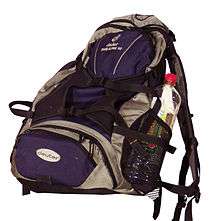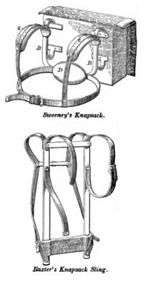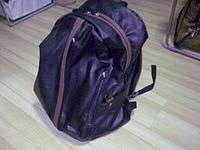Backpack



A backpack — also called bookbag, kitbag, knapsack, rucksack, pack, or sackpack — is, in its simplest form, a cloth sack carried on one's back and secured with two straps that go over the shoulders, but there can be variations. Lightweight types of backpacks are sometimes worn on only one shoulder strap.
Backpacks are commonly used by hikers and students, and are often preferred to handbags for carrying heavy loads or carrying any sort of equipment, because of the limited capacity to carry heavy weights for long periods of time in the hands.
Large backpacks, used to carry loads over 10 kg (22 lbs), as well as smaller sports backpacks (e.g. running, cycling, hiking and hydration), usually offload the largest part (up to about 90%) of their weight onto padded hip belts, leaving the shoulder straps mainly for stabilising the load. This improves the potential to carry heavy loads, as the hips are stronger than the shoulders, and also increases agility and balance, since the load rides nearer the wearer's own center of mass.
In ancient times, the backpack was used as a means to carry the hunter's larger game and other types of prey and as a way of easier transport for other materials. In the cases of larger hunts, the hunters would dismember their prey and distribute the pieces of the animal around, each one packing the meat into many wrappings and then into bags which they placed on to their backs. The bag itself would be made up of animal hide and skin and sewn together by animal intestines, which would be woven together tightly to make a sturdy thread-like material.
Terminology
The word backpack was coined in the United States in the 1910s. Moneybag and packsack were used before. They now occur mainly as regionalisms. The word rucksack is a German loanword mainly used in the UK and in Western military forces. In German, der Rücken means "the back (the part of the body)" and Sack for "bag". The name rucksack is cognate with the Danish Rygsæk, Norwegian Ryggsekk, Dutch Rugzak, Afrikaans Rugsak and Swedish Ryggsäck. Alternative names include Haversack, the term haversack more properly describes a small cloth bag on a strap worn over one shoulder and used to carry one or more "havers", havercakes or oatcakes. In German, a backpack with a rigid framework (or the framework itself) is called Kraxe. The British Army uses the word bergen for a large load-carrying rucksack, from a design issued during the Second World War.[1]
Backpacks can often simply be referred to as "packs", especially in outdoors contexts; though sometimes ambiguous compared to other bags such as saddlebags and duffel bags, context is generally sufficient for identification.
A bodypack is a backpack fitted with pocket(s) that are suspended on the wearer's front side (chest) and loaded in such a way that the load in the front and the load in the back are about equal. The majority of the load on a bodypack is carried by the hips. The ideal load carrying system should not disturb the wearer's natural posture, balance and movement of the body. The load must be dispersed onto the skeletal structure in a balanced way, and should not produce forces on the body forward, aft, right, or left.
Backpack designs
_2012-05-11_01.jpg)



Backpacks in general fall into one of four categories: frameless, external frame, internal frame, and bodypack. A pack frame, when present, serves to support the pack and distribute the weight of its contents across the body more appropriately, by transferring much of the weight to the hips and legs. Most of the weight is therefore taken off the shoulders, reducing the chance of injury from shoulder strap pressure (many backpacks equipped solely with shoulder straps can affect the posture of a person carrying more than 14 kg (30 lbs)), as well as being less restrictive of the upper body range of motion. Most backpacks are capable of being closed with either a buckle mechanism, a zipper, or a dry-bag type closure though a few models use a drawstring fitted with a cord lock for the main compartment.
Frameless
The simplest backpack design is a bag attached to a set of shoulder straps. Such packs are used for general transportation of goods, and have variable capacity. The simplest designs consist of one main pocket. This may be combined with webbing or cordage straps, while more sophisticated models add extra pockets, waist straps, chest straps, padded shoulder straps, padded backs, and sometimes reflective materials for added safety at night. These packs are generally produced inexpensively.
Some outdoor packs, particularly those sold for day hikes, ultralight backpacking and mountaineering are sometimes frameless as well.
The safety of some of the designs of these backpacks have been criticized by the UK NHS, many bag designs being deemed "unsafe" for children.
Sports
Sports and hydration backpacks are smaller with a profile closer to the body, wider straps and can come with water bladders and hip belts for running, cycling or hiking. Camelbak is one such company best known for its hydration pack. Running hydration packs are the smallest and lightest, many under 2 litres and most under six litres. They sit low on your back. Compression straps across the top of your body are common as are hip belts. Cycling hydration packs are six to ten litres sitting high on your back. Compression straps across the body are not necessary although weight still needs to be relatively low positioned. Although daypacks are small averaging ten to thirty litres, all Trekking and Hiking hydration packs are generally the largest and heaviest. Thirty five up to sixty five litres and above are common. Compression straps across the body and shoulders as well as hip belts are necessary.
External frame packs
External frame packs were designed to carry heavy loads (>20 kg or 40 lb), giving the wearer more support and protection and better weight distribution than a simple, frameless strapped bag. Wooden pack frames were used for centuries around the world. Ötzi the Iceman may have used one in Copper Age Alpine Italy,[2][3] though some archaeologists believe the frame found with the body was part of a snowshoe. Such packs are common in military and mountaineering applications;[4] metal versions first appeared in the mid-20th century.
The frame of an external frame pack is typically made from aluminum, other lightweight metal alloy, and recently reinforced synthetic polymers or plastic and is equipped with a system of straps and tautly-stretched netting which prevents contact between the metal frame and user's back. In addition to comfort, this "stand-off" provides the additional benefit of creating air circulation between the frame and the wearer's back. For this reason, external frame packs are generally considered to be a "cooler load" than internal frame designs. External frame packs have a fabric "sack" portion which is usually smaller than that of internal frame packs, but have exposed frame portions above and below the sack to accommodate attachment of larger items. In addition, the sack can often be removed entirely, permitting the user to customize the configuration of his load, or to transport a non-conventional load such as a quartered game animal. Military packs are often external frame designs due to their ability to carry loads of different shapes, sizes and weights.
Internal frame packs
The internal frame backpack is a recent innovation, invented in 1967 by Greg Lowe, who went on to found Lowe Alpine and Lowepro, companies specializing in backpacks and other forms of carrying bags for various equipment.[5] An internal-frame pack has a large fabric section around an internal frame composed of strips of either aluminum, titanium or plastic, sometimes with additional metal stays to reinforce the frame. A complex series of straps works with the frame to distribute the weight and hold it in place. The internal frame permits the pack to fit closely to the wearer's back and minimizes shifting of the load, which is desirable when participating in activities that involve upper-body movement such as scrambling over rocky surfaces and skiing. However, the tight fit reduces ventilation, so these type of packs tend to be more sweaty than external frame packs. The internal construction also allows for a large storage compartment; a few lash points (including webbing loops and straps for sleeping bags and other large items) may be present, but as the frame is completely integrated, it is difficult to securely lash larger and heavier items which do not fit inside the compartment to the outside of the pack. Internal frame packs originally suffered from smaller load capacity and less comfortable fit during steady walking, but newer models have improved greatly in these respects. In addition, because of their snug fit, the improved internal frame models have largely replaced external frame backpacks for many activities.
Daily use

A daypack is a smaller, frameless backpack that can hold enough contents for a day hike, or a day's worth of other activities. They are not large enough for average wilderness backpacking that use full-sized sleeping bags and backpacking tents, but may be large enough for ultralight backpacking. Padded or unpadded waist straps may be provided to distribute weight across the body.

In many countries, backpacks are heavily identified with students, and are a primary means of transporting educational materials to and from school.[6] In this context they are sometimes known as bookbags or schoolbags. The purchase of a suitably fashionable, attractive, and useful backpack is a crucial back-to-school ritual for many students.[7]
Typical school backpacks generally lack the rigid frame of an outdoor-style backpack and include only a few pockets in addition to the main storage compartment. While traditionally very simple in design, school backpacks are often made with padded shoulder straps and backs as well as additional reinforcement to hold large numbers of heavy textbooks, as well as safety features such as reflective panels to make the wearer of the pack more visible at night.
Backpacks are sometimes worn as fashion accessories, in which they perform the same function as a purse.[7] Some such backpacks designed specifically for women are no larger than a typical purse, and are generally associated with younger women.
Special-purpose backpacks


Some backpacks are specifically designed to carry certain items. Common examples include backpacks for small valuable items such as laptops and cameras;[7] backpacks designed to hold laptop computers in particular generally have a padded compartment to hold the computer and medium-sized pockets and flaps to accommodate accessories such as charger cables and cordless/corded mice. These are especially common in college and university settings. In order to supply these devices with electricity, a few high-end backpacks are equipped with solar panels.[8]
There are also single-strap packs that are essentially a hybrid between a backpack and a messenger bag.
Inexpensive, very simple packs that combine the drawstring and straps into a single piece of cloth or webbing are occasionally sold for use at sporting events and the like. Some high-end retailers (notably Apple Stores) use a similar design for their shopping bags as well.
Rolling backpacks are backpacks with wheels on the bottom and an extending handle. Because of their design, rolling backpacks reduce the strain on the user, though the shoulder straps may be used to carry the pack for short distances when the terrain is not suitable for wheels. Rolling backpacks are most commonly used while traveling by airplane or train.
Multi-Day Backpacks
Backpacks for hiking, particularly multi-day hikes, are commonly in the 40-80L range in size. Major manufacturers of these packs include:
- Arc'teryx
- Black Diamond
- Deuter
- Doite
- First Ascent
- Granite Gear
- Gregory
- Kelty
- Mammut
- Marmot
- Mountain Hardwear
- Mountainsmith
- Osprey
- Patagonia
- REI
- Salewa
- The North Face
Professional use
Backpacks are a standard part of the load-bearing equipment of soldiers, especially infantry, in most countries, and military-style packs are regularly available to civilians in military surplus stores. Well-known examples include the United States ALICE field pack and the British Army PLCE rucksack attachment, both of which are widely available to civilian markets both as actual military surplus (new or used) and as replicas. Such packs are often, though not always (e.g. the USMC's ILBE pack), external-frame packs, with the pack itself lashed or pinned to a metal or plastic carrying frame. For units that are entering combat situations, packs may be loaded heavily and can weigh in excess of 100 lbs. Each soldier may carry extra weapons, ammunition, rations, medical supplies, tents or other shelter material, and extra clothing.
Many police tactical units, as well as players of military-style combat games such as paintball and airsoft, use these military-style tactical backpacks and webbing for storing gear and ammunition. There is also a small but thriving industry devoted to creating historical reproductions of military gear; such companies generally produce period-appropriate uniforms and other gear in addition to backpacks.
Some more recent military/tactical designs, especially the MOLLE and ILBE packs used by the United States armed forces, are covered with webbing loop attachment points for increased carrying capacity.
Recently, at least one brand of backpack has been specially designed for professional cooks and culinary students. This sort of backpack is meant to safely carry knives, cooking tools, and other miscellaneous equipment such as notebooks, towels, and uniforms.
Image gallery
 MOLLE patrol pack |
Tropical Rucksack (front) |
Tropical Rucksack (side) |
Tropical Rucksack (back) |
Backpacks for travel

Backpacks are sometimes used as luggage, particularly as carry-on bags for airplane travel.
Backpacks form an essential part of the gear of the outdoor trekker and the urban backpacker, allowing more mobility and compactness than would be available to someone carrying most of their gear and clothing in a suitcase.
In addition to their use in outdoors pursuits, backpacks are sometimes used in other sports as well. Hydration packs, sometimes used by athletes and military personnel, carry water (in either a bladder or a rigid bottle) and have a tube connected to them from which the wearer can drink without removing the pack; this feature is also included in some more general-purpose hiking backpacks. Backpacks that carry skateboards have also become more popular in the youth culture.
See also
References
- ↑ National Army Museum: Bergen rucksack, War Department issue
- ↑ "The Iceman at the South Tyrol Museum of Archaeology". ArchaeologieMuseum.it. South Tyrol Museum of Archaeology. 2013. Retrieved 10 August 2014.
- ↑ The Three-Stick Roycroft Packframe
- ↑ Mountaineers
- ↑ "Innovations". Lowepro.
- ↑ Bruce Horovitz, "New 'badge' of cool: High-tech, high-fashion backpacks," USA Today, 20 August 2007, 1A.
- 1 2 3 Horovitz, 1A.
- ↑ John Kalish. "Sun Inspired: How To Build A Solar Backpack". National Public Radio. Archived from the original on 23 April 2009. Retrieved 10 May 2009.
External links
-
 Media related to Backpack at Wikimedia Commons
Media related to Backpack at Wikimedia Commons
| ||||||||||||||||||||||||||||||